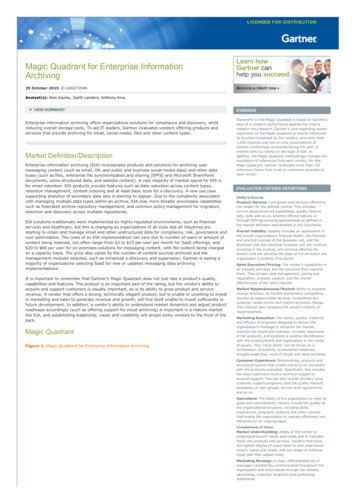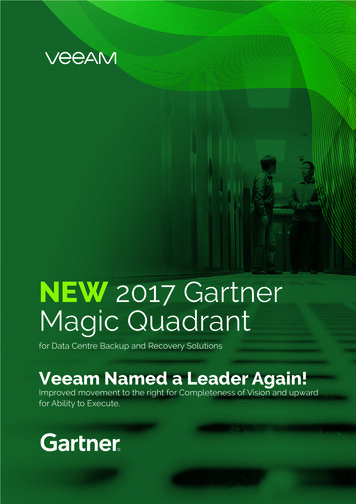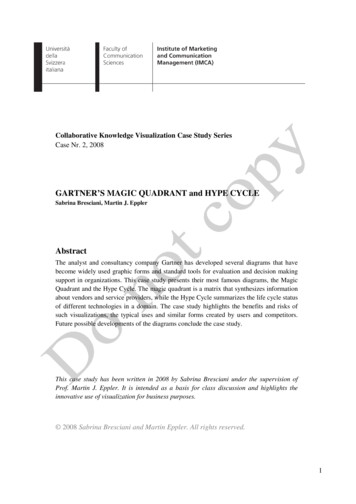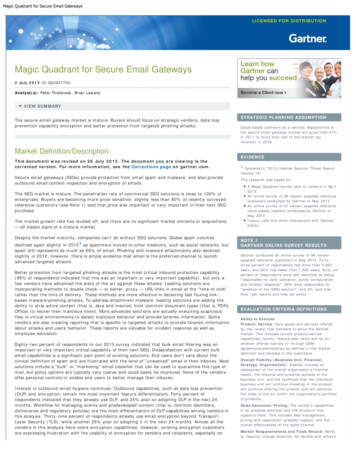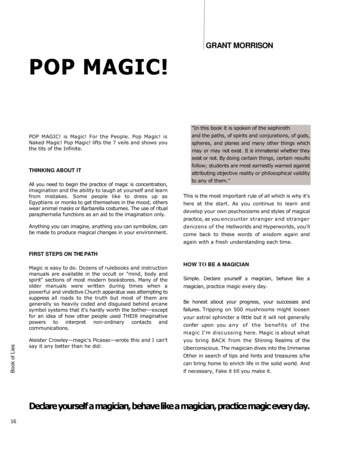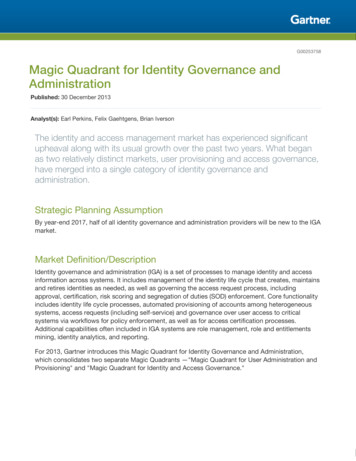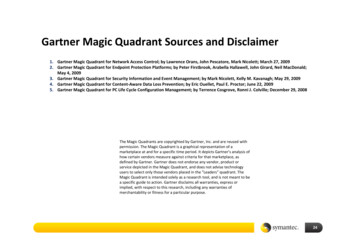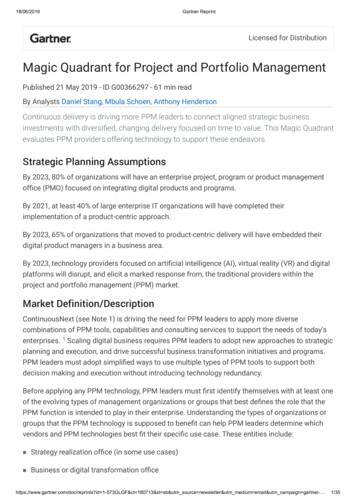
Transcription
18/06/2019Gartner ReprintLicensed for DistributionMagic Quadrant for Project and Portfolio ManagementPublished 21 May 2019 - ID G00366297 - 61 min readBy Analysts Daniel Stang, Mbula Schoen, Anthony HendersonContinuous delivery is driving more PPM leaders to connect aligned strategic businessinvestments with diversified, changing delivery focused on time to value. This Magic Quadrantevaluates PPM providers offering technology to support these endeavors.Strategic Planning AssumptionsBy 2023, 80% of organizations will have an enterprise project, program or product managementoffice (PMO) focused on integrating digital products and programs.By 2021, at least 40% of large enterprise IT organizations will have completed theirimplementation of a product-centric approach.By 2023, 65% of organizations that moved to product-centric delivery will have embedded theirdigital product managers in a business area.By 2023, technology providers focused on artificial intelligence (AI), virtual reality (VR) and digitalplatforms will disrupt, and elicit a marked response from, the traditional providers within theproject and portfolio management (PPM) market.Market Definition/DescriptionContinuousNext (see Note 1) is driving the need for PPM leaders to apply more diversecombinations of PPM tools, capabilities and consulting services to support the needs of today’senterprises. 1 Scaling digital business requires PPM leaders to adopt new approaches to strategicplanning and execution, and drive successful business transformation initiatives and programs.PPM leaders must adopt simplified ways to use multiple types of PPM tools to support bothdecision making and execution without introducing technology redundancy.Before applying any PPM technology, PPM leaders must first identify themselves with at least oneof the evolving types of management organizations or groups that best defines the role that thePPM function is intended to play in their enterprise. Understanding the types of organizations orgroups that the PPM technology is supposed to benefit can help PPM leaders determine whichvendors and PPM technologies best fit their specific use case. These entities include: Strategy realization office (in some use cases) Business or digital transformation officehttps://www.gartner.com/doc/reprints?id 1-573GLGF&ct 180713&st sb&utm source newsletter&utm medium email&utm campaign gartner- 1/35
18/06/2019Gartner Reprint Enterprise portfolio office Enterprise program and project capability center Reporting enterprise program management office PMO Collaborative work management teams or groupsOnce PPM leaders understand the makeup of their management organization and their specificuse cases clearly, they can turn to the PPM market for supporting technology. The estimated 3.1billion PPM market represents a variety of existing and emergent PPM submarkets. 2 It is a strongmarket, but one that is commoditizing in some areas and diversifying in others simultaneously.The market is also polarizing, with clear distinctions between standardizing strategic portfoliodecision making and management and diversifying execution methods and approaches based ontime to value.Connecting strategy and execution for true alignment is also as equally important now asallowing these two main PPM functions to operate independently from one another whenappropriate. This is driving a natural proliferation of complementary PPM tools supporting boththe strategic and execution activities playing out as part of digital business.New PPM Market ChallengesThe latest digital trends are presenting some clear challenges to the PPM market, and thesechallenges have yet to be met. There are new, emergent approaches to both strategic planningand execution requiring more innovative PPM technology. Demand for the latest digitaltechnologies (e.g., AI, robotic process automation [RPA]) in all enterprise software markets is alsoapplying pressure to providers in the PPM market.Digital technology challenges for the PPM market include: Strategy-to-execution alignment and management Standardized enterprise portfolio decision making connected to diversified execution anddelivery Continuous change Supporting the shift from project-based management to digital-product-based management Funding and resourcing agile investments at the portfolio level Funding and resourcing digital products at the portfolio level AI-enabled PPM technology, including conversational AI and machine learning (ML)https://www.gartner.com/doc/reprints?id 1-573GLGF&ct 180713&st sb&utm source newsletter&utm medium email&utm campaign gartner- 2/35
18/06/2019Gartner Reprint RPA-enabled PPM technologyPPM market providers recognize these challenges and are reacting to them in many ways, but aredoing so incrementally, as opposed to delivering major releases of functions in these areas. AsPPM evolves in its best practices to support scaled digital business, so too will the PPM vendorsand technologies available in the market. 3Established PPM vendors are investing in new combinations of product capabilities and/oracquiring other PPM-related vendors and products to meet these varied needs. Pricing modelsare beginning to change to better suit customer needs and provide more flexibility in the usage ofdifferent types of licenses and functionality. AI and RPA are being explored by providers for laterinfusion into their existing product offerings. Customers and prospects, however, are clamoringfor these things now.Prospective PPM tool customers should look carefully at the market defined by this MagicQuadrant research to determine what part of their needs the products discussed will meet.However, they should also consider other Gartner PPM market research covering PPM softwaresubmarkets (e.g., strategy execution management, low-cost project management tools) toaddress all PPM use cases in their organization. Organizations moving aggressively towardContinuousNext and scaled agile constructs may need to look beyond these traditional players tocomplete a technology profile that covers digital business comprehensively.Portfolio Versus Execution ConfigurationsAt the portfolio level, PPM leaders are interested in aligning and prioritizing the contributions theymake and the work they do with value markers defined by business leaders. Those markersinclude strategy realization, positive business outcomes, transformed business and operatingmodels, and the resolution of persistent business challenges. PPM technology configured forportfolio management can support many of these interests, but might also require augmentationwith technologies that complement the portfolio management function.At the execution level, PPM leaders are interested in diversifying their use of traditional andalternative work and project execution methods. They wish to reduce overall project durations,promote continuous customer responsiveness and satisfaction, and base any executionapproach they apply to varied work efforts on the business’s perceived time to value for thoseefforts. If agile tooling is already employed for agile and iterative work — for example, AtlassianJira, Broadcom (CA Technologies) Rally and CollabNet VersionOne — then integration of thistooling with a PPM technology is now a priority requirement.Standard Use Cases and Critical CapabilitiesNew approaches toward executing transformational initiatives in the midst of ContinuousNextdrive a variety of distinct PPM technology needs. The proliferation of submarkets for PPM is adirect reflection of these differing technology needs and respective use cases we see amongteams, departments and enterprises seeking out PPM software. In response, the PPM markethttps://www.gartner.com/doc/reprints?id 1-573GLGF&ct 180713&st sb&utm source newsletter&utm medium email&utm campaign gartner- 3/35
18/06/2019Gartner Reprintcontinues to grow and expand to support a variety of PPM use cases involving different types ofuser groups, each of which has its own distinct goals and challenges.Gartner specifically defines four distinct PPM use cases in our Critical Capabilities research,including IT PPM, enterprisewide PPM, reporting PPM and collaborative PPM.PPM capabilities identified as essential or critical include: Project demand management Project planning and management Time management Resource management Resource capacity planning Project portfolio management Project collaboration Program management Reporting services Security and user management Integration UsabilityRisk management and change management are also important capabilities but are notspecifically measured in our PPM Critical Capabilities research as major items; rather, they arecovered as underlying capabilities by some of the ones included in the list above.PPM vendors apply several different approaches to providing PPM critical capabilities in the fourdistinct PPM use cases. Many are compelled to provide a broad set of PPM software productsachieved largely through mergers and acquisitions (M&As). Others offer one product and focuson developing and extending it directly, and/or integrating it with other tools and softwareproducts, to cover the new needs that their base products cannot cover.PPM software providers covered under this market definition aim to support the selection,planning and execution of a variety of different work packages or containers, including traditionalwaterfall projects, as well as iterative and agile projects. Comprehensive support for themanagement of digital products is still in a very early stage.https://www.gartner.com/doc/reprints?id 1-573GLGF&ct 180713&st sb&utm source newsletter&utm medium email&utm campaign gartner- 4/35
18/06/2019Gartner ReprintPPM providers often fold in collaboration and communication capabilities, and allow work teamsand project offices to report, monitor and identify course correction in resource-intensive projectand work environments. Providers included in this Magic Quadrant offer these capabilities directlythrough their own products, but frequently recognize that specific integration points may also beneeded to connect niche tools or data sources.AI- and RPA-Enabled PPMContinuousNext requires PPM best practices to evolve toward continuous and adaptive strategicand operational planning, streamlined and efficient communication, and rapid and continuousexecution. 4 Without also evolving the enterprise’s PPM technology foundation to support thesemodern best practices, increasingly intolerable levels of administrative overhead begin to surface,leaving little or no room for innovation.Currently, PPM leaders struggle to avoid this situation or find modern technologies to optimizeand support the new roles, responsibilities and delivery methods of their PPM function. ApplyingAI to PPM-enabling technologies and disciplines appears to be a promising answer to thisstruggle, and yet the PPM market is in an embryonic stage as it relates to AI-enabled PPM.5End-user fatigue is also officially setting in as PPM leaders and project professionals areexpected to interact with, update and share information with many or all of these different toolsand technologies. A change or update that a PPM end user must make to one software system ortool could require additional logins and keying of information into others. Traditional APIs andhard-coded integration approaches are not enough to reduce the amount of time that PPMleaders and project professionals must spend logging in and out of and updating multiplesystems used for PPM.RPA can remedy the many integration inefficiencies found among the tools and technologiesused for PPM in enterprises investing in digital business. RPA investments among digital leaderswill spike in the next few years and, by 2022, enterprise software vendors will provide strong AIand RPA-enabled options in their technology offerings for customers. The PPM market must alsofollow suit. Currently, however, the PPM market is in the very early stages of providing RPAenabled PPM.Magic QuadrantFigure 1. Magic Quadrant for Project and Portfolio Managementhttps://www.gartner.com/doc/reprints?id 1-573GLGF&ct 180713&st sb&utm source newsletter&utm medium email&utm campaign gartner- 5/35
18/06/2019Gartner ReprintSource: Gartner (May 2019)Vendor Strengths and CautionsBroadcom (CA Technologies)Broadcom (CA Technologies) provides one flagship PPM product, Clarity PPM, with on-premisesand SaaS deployment options. A second product, Broadcom Rally, provides an agile developmenttool that can be purchased as a stand-alone tool or integrated with Broadcom Clarity PPM.Strengths To provide more flexibility and choice for its larger-size customers, Broadcom introduced a newpricing and licensing model. The new model allows customers to shift license types from teammembers to power users. Additionally, customers no longer need to predict a fixed set ofdifferent types and amounts of licenses before they buy, as this newer model is based on, andallows for, varied d 1-573GLGF&ct 180713&st sb&utm source newsletter&utm medium email&utm campaign gartner- 6/35
18/06/2019Gartner Reprint Broadcom continues to transform the Clarity PPM user experience, infusing the entire productwith a modern UX lauded by customers and end users, including team members, projectmanagers and portfolio managers. Out-of-the-box integration between Clarity PPM and Broadcom Rally allows customers tostandardize on portfolio-level communication, strategic alignment and decision making, whilealso supporting both waterfall and agile approaches to work management. The integration alsoallows Clarity to organize the funding of agile work.Cautions Broadcom’s Clarity PPM is robust and comprehensive, and supports many different roles forPPM. The strength of the product and cost, however, might not always meet the needs of smallor midsize PPM environments. Broadcom recognizes the need to continue to provide customer relationship touchpoints forClarity PPM’s large installed base. Customers may experience impacts related to customerservice, as Broadcom transitions CA Technologies’ sales and support functions to support itsoverall strategy. Broadcom PPM products currently lack AI features like conversational AI and ML. These wouldallow PPM leaders and project professionals to reduce the amount of manual data entryrequired to feed Clarity PPM and query information from it, or reduce the amount of manualplanning required to use the product effectively.CerriCerri provides two PPM products, Genius Project and Cerri Apps, with on-premises and cloudbased options for each.Strengths Cerri introduced Cerri Apps (Cerri), a collaboration platform consisting of a series ofapplications (e.g., Task, Central and Calendar) to provide a more collaborative and agile workexperience for users. This provides a foundation for its increasing agile and mobile workmanagement support. Genius Project is mainly suited for small and midsize businesses. The addition of Cerriapplications will further extend Cerri’s appeal to users requiring a lighter-weight, yet functional,experience. Cerri is currently modernizing Genius Project by moving it off of its legacy architecture andenabling better performance and ints?id 1-573GLGF&ct 180713&st sb&utm source newsletter&utm medium email&utm campaign gartner- 7/35
18/06/2019Gartner Reprint Currently, neither Genius Project nor Cerri applications support integration with third-party,agile-friendly products, such as Atlassian Jira or CollabNet VersionOne. As Cerri focuses itsattention on building software technologies facilitating collaborative work, it must also supportintegration to these types of third-party agile work applications. Cerri is very focused on improving and accelerating its product development efforts. As thisevolves, the vendor is expected to introduce products on more modern architecture. This willrequire it to invest more readily in migration services and support for existing customers, and toensure that there is enough support personnel to help the customer base move to a moremodern PPM product set. Cerri is in the midst of transitioning away from its existing legacy architecture in an effort toexpedite innovation in other areas (e.g., chatbots, AI, ML), Until this transition is completed,support for AI-enabled PPM will not be readily available in its PPM products.ChangepointChangepoint offers two main PPM products supporting the needs of its customers andprospects. Daptiv PPM is a cloud-based service, and Changepoint, its namesake product, offerson-premises and private cloud deployment options.Strengths Changepoint has introduced Daptiv Connect, a cloud-based integration platform powered byDell Boomi allowing Daptiv PPM to connect to third-party applications and offered for a flatannual fee. Changepoint manages and maintains these integrations for its customers as aservice, rather than relying on third-party partners to build one-off integrations using a standardAPI. Changepoint aligned its PPM and enterprise architecture (EA) products into an EnterprisePortfolio Management (EPM) offering, which provides customers adopting agile program andproduct management with continuous planning capabilities tightly integrated with multimodework execution. Changepoint introduced an improved resource management capability that enables workforceplanning for enterprises. This allows customers to engage in continuous planning and drivesfaster execution, while ensuring effective resource utilization and financial visibility.Cautions Changepoint is taking initial steps to respond to increasing market demand for a more modernPPM technology UX, such as AI-driven visualization, natural language processing (NLP) andML. Currently, however, Changepoint products do not yet provide robust AI-enabled PPM. Changepoint products can be configured to handle multiple work methods, including agile andwaterfall. But as PPM increasingly shifts from a project focus to a resourced digital producthttps://www.gartner.com/doc/reprints?id 1-573GLGF&ct 180713&st sb&utm source newsletter&utm medium email&utm campaign gartner- 8/35
18/06/2019Gartner Reprintapproach, the vendor will need to add this support to its products for customers engaged in theshift. Changepoint and Daptiv offer strong capabilities in project and portfolio management. But asdigital transformation leads to more overarching business programs affecting enterprises,Changepoint will need to improve its support for program management in its PPM products.ClarizenClarizen provides three cloud-based PPM products: Clarizen One (formerly Clarizen), Clarizen Goand Clarizen Eagle.Strengths Clarizen amended its PPM product portfolio to address additional uses cases and address abroader set of needs across the enterprise. In addition to Clarizen One, the vendor now offersClarizen Go, which targets agile- and team-based work management. Clarizen Go integratesdirectly with Clarizen One to provide team progress updates. Another new product, ClarizenEagle, offers strategic portfolio-level management and alignment to work performed in ClarizenOne, and can also be sold as a stand-alone solution. Supporting its executive-level end users, Clarizen One now includes Slide Publisher, which canbe used to expedite the creation of executive-ready presentations that provide summary-levelstatus updates based on user-defined templates and preferences. As an initial step into AI-enabled PPM, Clarizen One includes Clarizen Bot, an integration withSlack or Microsoft Teams that uses bot technology. Clarizen Bot leverages NLP to enhancepersonal productivity, by identifying actions for completion for end users (e.g., time entry forappropriate tasks) as well as smoother tool navigation.Cautions As the use of tools to support both the process and the system of strategy execution continuesto evolve, the vendor will need to accelerate the enhancement of Clarizen Eagle’s integrationcapabilities in this increasingly competitive space. While Clarizen Go is a move in the right direction to support the increasing needs for teamcollaboration and engagement, Clarizen will need to improve the UX and user satisfaction withits base mobile application for Clarizen One. Clarizen leverages customer feedback to provide more modern, cleaner screen presentations,and the look and feel of Clarizen One. Further improvements to Clarizen One’s UI, specifically inareas such as the general presentation of tool features and more simplistic views forpresenting project information, would benefit customers and end id 1-573GLGF&ct 180713&st sb&utm source newsletter&utm medium email&utm campaign gartner- 9/35
18/06/2019Gartner ReprintKeyedIn offers one main PPM product, KeyedIn Projects.Strengths KeyedIn Projects offers users the flexibility to configure their project workflows, gating andapprovals based on preconfigured project types supporting varied work and deliverymethodologies (e.g., waterfall and agile configurations), using a Kanban approach. KeyedIn Projects’ reporting API enables point-and-click integration and allows users to buildsimple queries to expose data that can be consumed by JSON-compatible businessintelligence and reporting tools. With primary installations in small and midsize enterprises, KeyedIn Projects can be configuredin ways that support ease of use among end users who might not be PPM technology powerusers or experienced in the use of project management software.Cautions KeyedIn Projects provides users with the ability to categorize projects by project type, thusallowing for various types of governance workflow. KeyedIn Projects does not yet supportadvanced capabilities relative to resourced digital product portfolio management. KeyedIn Projects does not yet support AI-enabled PPM or RPA for its customers. While there has been an emphasis on providing users with added flexibility for configurationand reporting, KeyedIn should not avoid scaling to continue to provide the professional servicesthat have been applauded by users in the past.Micro FocusMicro Focus provides one main PPM product, Micro Focus PPM, with on-premises and cloudhosted deployment options.Strengths Micro Focus is responding to customer demand for continuous strategic portfoliomanagement by providing a tight connection between tools used for agile and other workmanagement and its portfolio management capabilities. It also provides the ability to trackdigital products at the portfolio level to manage funding and resources without having to godirectly into an agile tool. Micro Focus improved the look and feel of its PPM product with a more modern UX, includingnew charting and graphics libraries enabling a new dashboard system. This allows for easieruser configuration and additional out-of-the-box content with new chart types. Micro Focus PPM includes evolving enterprise agile support, by allowing users to definestrategies using its portfolio management features, analyze various portfolio scenarios basedhttps://www.gartner.com/doc/reprints?id 1-573GLGF&ct 180713&st sb&utm source newsletter&utm medium email&utm campaign gartner 10/35
18/06/2019Gartner Reprinton value metrics and potential benefits realization, and advance approved work packages fordetailed execution.Cautions Micro Focus PPM only supports mobile accessibility natively and does not yet offer a mobileapplication available on Google Play or in the Apple Store. Micro Focus continues to evolve its SaaS strategy. However, a significant portion of the MicroFocus PPM installed base remains on on-premises deployments. For Micro Focus customersinterested in adopting or migrating to a public cloud-hosted deployment, be aware that thevendor is still building its expertise in these new environments. As customers shift from project-based to digital-product-based methods, Micro Focus will needto continue to evolve its support for collaborative delivery teams. Micro Focus released itsinitial capabilities in this area in February 2019, and more features are slated for futurereleases. Currently, however, these new capabilities are in the early stages of adoption bycustomers.MicrosoftMicrosoft provides two main PPM products, Microsoft Project Server (on-premises solution) andMicrosoft Project Online (cloud-based, hosted by Microsoft in Office 365). Other PPM productsinclude Microsoft Project, Microsoft Planner and Microsoft Teams.Strengths Microsoft is strengthening its messaging to customers and its partner network to reducecomplexity and confusion on how to implement and leverage its PPM technologies. Thisincludes helping customers more easily understand how to combine and configure the variousMicrosoft PPM components to meet specific PPM and business needs. Microsoft PPM offerings allow users to evaluate the impact of unplanned work on portfolios ofprograms and projects. Users can capture and track formal project or work change requests,and assess the impact of these changes on work, durations, costs and resources. Microsoft introduced a new platform it calls Project Service, promising a modern approach towork management. This evolving product leverages and integrates with different Microsoftcomponents, such as Microsoft Flow, Microsoft Teams, Microsoft Planner and MicrosoftProject Online, in a more modern way.Cautions Microsoft’s new Project Service is relatively new and untested in the marketplace. Existing andnew Microsoft Project Online customers will have access to Project Service as part of theirProject Online subscriptions. These customers should refrain from overly customizing (ratherhttps://www.gartner.com/doc/reprints?id 1-573GLGF&ct 180713&st sb&utm source newsletter&utm medium email&utm campaign gartner 11/35
18/06/2019Gartner Reprintthan configuring) their use of Project Online until the two offerings are combined into oneplatform and unified UX. Microsoft offers many PPM-enabling products and options for its customers, especially projectmanagers who want to successfully manage and report on their projects. However, continuedcustomer feedback indicates that Microsoft must improve its customer support specifically forPMOs and enterprise PMOs (EPMOs). Navigating the many PPM technology options Microsoftoffers can be confusing for PMOs and EPMOs interested in exploring how they can automatePPM using Microsoft products. Project Online offers strong capabilities for named resource management at the detailedproject and execution levels. However, dynamic resource management at the portfolio level,with the ability to create multiple scenarios and assess potential positive or negative impacts,would be a welcome addition that could expose macrolevel budget and schedule risks.One2TeamOne2Team offers one main PPM product, One2Team.Strengths One2Team provides improved resource management and capacity planning capabilities withthe inclusion of an additional module that allows One2Team customers to perform capacitymanagement, what-if analysis and dynamic replanning independent of, and without impacting,the product’s role as a PPM execution system of record. One2Team now offers preconfigured options for new product innovation (NPI),telecommunications (e.g., infrastructure rollouts) and IT PPM. This allows customers toexpedite their implementations, while also allowing configuration supporting the specific PPMneeds and varied use cases of an enterprise. To support the provision of real-time information and enablement of collaboration across boththe execution level and portfolio level of PPM, One2Team now offers what-if analysiscapabilities for building and comparing alternative portfolio scenarios.Cautions One2Team is transitioning from managing 100% of its implementations with internal staff tousing select implementation partners to support growth in underserved markets. As One2Teamcontinues to scale, it must invest in more formal onboarding, training and collaboration withimplementation partners to avoid dampening its reputation for customer responsiveness. One2Team is making incremental investments in pursuing North American markets and mustcontinue to do so to strengthen its brand, and marketing and sales execution, in this region. One2Team does not yet provide PPM-enabled AI and RPA as part of its PPM offering.https://www.gartner.com/doc/reprints?id 1-573GLGF&ct 180713&st sb&utm source newsletter&utm medium email&utm campaign gartner 12/35
18/06/2019Gartner ReprintONEPOINT ProjectsONEPOINT Projects offers one main PPM product, ONEPOINT Projects.Strengths ONEPOINT continues to build on its strength in bidirectional integration with Atlassian Jira.ONEPOINT Projects’ Jira integration now allows users to automatically synchronize customfields, facilitating more modular planning for large or complex initiatives. Version 18 of ONEPOINT Projects demonstrates the vendor’s commitment to improving theproduct’s UI and usability. Version 18 includes an improved look and feel, with the addition ofKanban boards for building and managing to-do lists and activities, as well as improved workbreakdown structure views. ONEPOINT Projects is attractive for small and midsize organizations, given its accelerateddeployment durations and ease of use. A free trial option is offered so that prospectivecustomers can test and apply the use of the product to a small subset of users before makinga purchasing decision.Cautions ONEPOINT Projects version 18 includes improved portfolio management capabilities such asscenario planning and an upgraded portfolio dashboard. While the provided capabilities may beappropriate for small and some midsize organizations, they might not always suffice for largerenterprises. ONEPOINT provides mobile support via ONEPOINT 360 and ONEPOINT ME (iOS only), butrequires improved UI capabilities to better support those project stakeholders requirin
PPM function is intended t o play in their enterprise. Understanding the types of or ganizations or groups that the PPM technology is supposed t o benefit can help PPM leaders determine which vendors and PPM technologies best fit their specific use case. These entities include: Strategy realization office (in some use cases)
